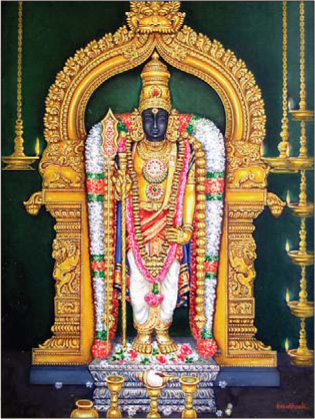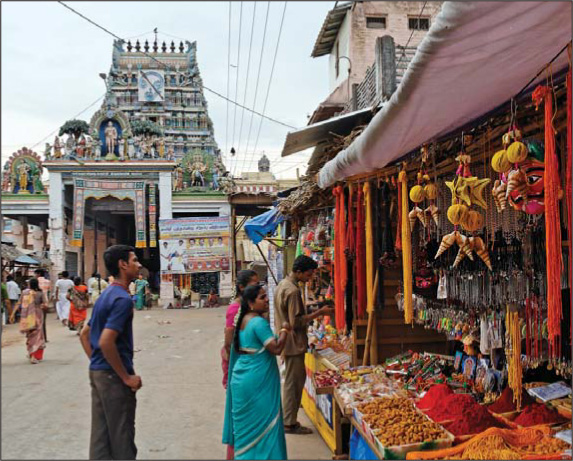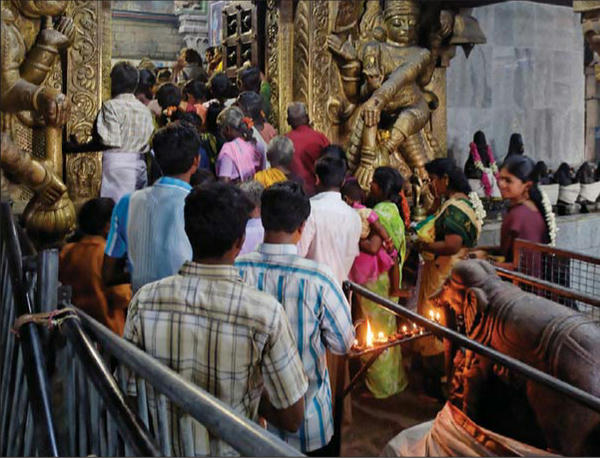

The guru: Viewing Swamimalai’s three levels from the Northeast
• • • • • • • • • • •§
 IDING ON THE INTENSITY OF PALANI, WE PREPARE OURSELVES for the serene rapture of Murugan’s fourth abode. Known in ancient days as Tiruveragam, the wooded village of Swamimalai is located five kilometers west of Kumbakonam on the banks of a tributary of the Kaveri River. We drive to Trichy, then take the train to Kumbakonam. Accommodations in Swamimalai are almost nonexistent, so it is best to stay in Kumbakonam or Tanjavur (32 km away) and take a bus or hired car to Swamimalai for the day.§
IDING ON THE INTENSITY OF PALANI, WE PREPARE OURSELVES for the serene rapture of Murugan’s fourth abode. Known in ancient days as Tiruveragam, the wooded village of Swamimalai is located five kilometers west of Kumbakonam on the banks of a tributary of the Kaveri River. We drive to Trichy, then take the train to Kumbakonam. Accommodations in Swamimalai are almost nonexistent, so it is best to stay in Kumbakonam or Tanjavur (32 km away) and take a bus or hired car to Swamimalai for the day.§
The Arulmigu Sri Swaminatha Swami Tirukkoyil is a small, well-maintained temple rising to 60 feet on an artificial hillock constructed from granite stones. One enters from the south or east side and arrives within the third prakaram, at ground level. A thick, high wall protects the complex from the sounds and vibrations of the outside world. Here there are shrines to God Siva as Sundareswarar and Shakti as the Goddess Meenakshi.§
After circumambulating in the third prakaram, we ascend the steep steps to the second prakaram. Other than a family of green parrots who enjoy the temple’s outer precincts, this is a quiet, austere place. There is a small mandapam on the east side dedicated to Saint Arunagirinathar and the Tiruppugal he sang in devotional wonder of Murugan. This small open-air pavilion, situated directly underneath the kodimaram, or temple flagpole, is a wonderful place for undisturbed meditation.§

A. MANIVEL§
A painting of Swaminatha Swami
• • • • • • • • • • •§
Another flight of steps leads to the kodimaram and Vinayagar shrine. There are sixty steps in all, representing the sixty-year cycle of the Hindu calendar. This cycle is based on the planet Jupiter, symbol of the guru in Hindu astrology. This is especially significant at Swamimalai, as it is here that Murugan is the guru, known as Swaminathan.§
The first prakaram is enclosed, giving us the feeling of being in a cave. Only small openings vent the abundant camphor and homa smoke. Deities line the north wall. A glorious, silver-clad shrine for the utsava murti draws almost as much attention as the main sanctum.§
Instead of Murugan’s usual peacock, we are surprised to find an elephant vahana facing the main shrine. The priest who was our guide, Sivasri P. Ganesa Gurukkal, senses our wondering and explains, “Swaminathan rides Indra’s elephant.” As the story goes, Indra, the King of Gods, left behind His white elephant when He stopped here to worship Murugan.§
From here devotees ascend a few steps and pass through a brass-covered doorway onto a raised platform for standing darshan. There is room for many to stand, but those who pay are allowed to sit directly in front of the sanctum on a marble floor during the puja.§
With hair in topknot and a large preceptor’s danda in hand, the black stone murti is a full six feet tall. It is dark inside the shrine, but the power of the guru can be felt like an outpouring of love and wisdom. An abhishekam begins just as we sit down. Oil, a mixture of herbs, spices and water called kootu, abundant milk, yogurt and sandalwood paste are poured over the life-size murti in rapid succession.§
These twice-born, tuned to the hour of worship in wet clothes clad, and palms lifted overhead, laud themselves and chant the Vedic lore enshrined in the secret word of letters six, oft repeated and flowers offered at proper time. Thus they glorify Him, and for such worship, our Lord doth dwell in Eragam in joyful bliss.§
TIRUMURUGARRUPADAI 184-189§

Going in and in: The south entrance is surrounded by vendors offering kumkum, turmeric and sacred threads
• • • • • • • • • • •§

ALL PHOTOS: M. AMIRTHAM/DINODIA§
Devotees line up by Murugan’s elephant vahana on their way to the main mandapam
• • • • • • • • • • •§
The sandalwood is mixed to such a smooth consistency that it covers the body thickly and remains like a coat of amber paint. The priest then draws eyebrows, eyes and mouth on the face. He performs a prolonged arati. Passing the lamp before Murugan with steady deliberation, he lingers now and again to allow us all to see the murti’s refined features. Accented by the yellow sandalwood and illumined by the delicate flame, Murugan’s form draws us into rapt attention. Time stands still. Swaminathan is then rinsed, and the panchamritam and vibhuti are poured. The curtain is closed longer than usual while the Deity and shrine are meticulously cleaned and fresh white clothing and a silver crown and kavacham (ornate metal covering) for hands and feet are put on. A priest pours oil onto and then speedily lights the huge alankara dipam, a multi-tiered lamp with 108 wicks. Suddenly one priest throws the curtain open and a second offers the lamp amidst a flurry of chanting, then quickly passes it back out of the shrine where a helper puts it out with a few deft waves of the hand.§
After the head priest offers a multitude of other lamps, mudras and mantras, he performs the final arati. The priests take off the murti gigantic garlands that have been offered throughout the day and give them to devotees. As this evening abhishekam finishes, everyone feels copiously blessed.§
Escorting the three of us around a profusion of subsidiary shrines, Ganesa Gurukkal proudly declares, “As Adisaivas, we maintain the tradition of chanting only Sanskrit inside the sannadhi (sanctum).” He is referring to the modern-day trend, followed in less strict temples, of performing entire pujas in the Tamil language. He is also emphasizing the special importance of Sanskrit chants at this temple.§

Worship with light: Young devotees offer ghee lamps for Shanmuga, Valli and Devayanai
• • • • • • • • • • •§
According to Ratna Navaratnam, the brahmin priests at Swamimalai traditionally chant Murugan’s six-lettered Sanskrit mantra, “Sa-ra-va-na-bha-va,” during long periods of meditative japa. She observes that Swamimalai is linked to the anahata chakra, the heart center, which powers the faculties of direct cognition and comprehension. Here, the aspirant attains a mountaintop consciousness: an objective apprehension of the whole of existence. In a split second, complete knowledge of a subject may be known, directly as a boon and blessing from Murugan. Navaratnam writes of the metaphysics behind the relationship of Murugan’s six temples to the chakras, “The chanting of the mystical letters of spiritual potency is the propelling force of an inward spiritual pilgrimage in the form of an introspective meditation. The focal point of meditation is said to undergo a shifting process from the lower centers to the highest center, passing through six stages. These six stages can be taken to symbolically represent the six abodes of Murugan in Tirumurugarrupadai.”§